Pterocles alchata
| Pin-tailed sandgrouse | |
|---|---|
 |
|
| Scientific classification | |
| Kingdom: | Animalia |
| Phylum: | Chordata |
| Class: | Aves |
| Order: | Pteroclidiformes |
| Family: | Pteroclididae |
| Genus: | Pterocles |
| Species: | P. alchata |
| Binomial name | |
|
Pterocles alchata (Linnaeus, 1766) |
|
The pin-tailed sandgrouse (Pterocles alchata) is a medium large bird in the sandgrouse family. It has a small, pigeon like head and neck and a sturdy, compact body. It has long pointed wings, which are white underneath, a long tail and a fast direct flight. Flocks fly to watering holes at dawn. The call is a loud kattar-kattar. This gregarious species breeds on dry open treeless plains and similar habitats. Its nest is a ground scrape into which two or three cream-coloured eggs with cryptic markings are laid. Both sexes incubate the eggs.
The pin-tailed sandgrouse is about 35 centimetres (14 in) long. Its head and upperparts are yellowish-green. The underparts are white with a chestnut breast band separating the belly from the green neck. Sexes are somewhat similar, but the female is better camouflaged and has a shorter tail than the male. There are two subspecies; P. a. alchata breeds in southern Europe and P. a. caudacutus breeds in northwestern Africa, the Middle East and southeastern Asia. It is a partial migrant, with some Asian birds moving to the Middle East and northern Pakistan in winter. Males of the eastern race have duller underparts than the European birds, and the females have white, rather than yellow, wing coverts.
There are two subspecies. The nominate race, P. a. alchata, breeds in Iberia and southern France, and the eastern form P. a. caudacutus (Gmelin, 1774) is found in northwest Africa, and from southeast Turkey east to Kazakhstan.
The pin-tailed sandgrouse is a robust, medium-sized bird about 31 to 39 centimetres (12 to 15 in) in length. The general colouring is cryptic, a blend of barred and flecked olive green, brown, buff, yellow, grey and black. The underparts and the feathered legs are dull white.
The sexes are different and the male's plumage varies with the time of year. In the breeding season, the male has the crown, most of the neck, the back and under-wing coverts a yellowish-green colour with dull yellow spots in the shoulder region. The cheeks are also yellow with a narrow black line extending from the beak, through the eye to the nape of the neck. The irises are brown and the beak is slatey grey. There is a black patch on the throat immediately below the beak and below this, there is a broad, reddish-brown band round the breast, bordered by a thin black stripe above and below the band. The outer wing coverts are chestnut edged with black and white and the primaries are black with pale edges which gives both the leading and trailing edges of the wing the appearance of a black rim in flight. The rump and the tail are distinctly barred in black and brownish-yellow and the streamers on the central tail feathers are slate-grey. Outside the breeding season, all the upper parts, including the crown and cheeks, are barred in black and brownish-yellow and the throat loses its black patch, becoming whitish.
...
Wikipedia

